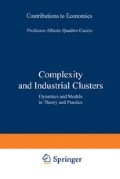Abstract
Regional clusters and local organisation of the industry have been proved to be basic elements of economic growth and innovation. The understanding of the processes underlying local development is thus pivotal. The paper attempts to contribute to this aim through the analysis of Toulouse, in the French southwest region Midi-Pyrénées, and Sophia Antipolis, in the southeast French Riviera. Both be considered as the outcomes of the French national system of innovation and the process of decentralisation initiated in the late sixties, and are today well known centres of high technology activity. But, as the numerous failed experiences of top-down reinforcement suggest, the factors the two areas have been endowed cannot explain as such the emergence and development of local innovative milieux. Considering clusters as evolving open complex systems, the paper analyses the reconfigurations of the clusters implied by changes in internal and external conditions that have led to endogenous innovative processes characteristic of technopoles.
Access this chapter
Tax calculation will be finalised at checkout
Purchases are for personal use only
Preview
Unable to display preview. Download preview PDF.
References
Allinne, J. P. (1996), “Les technopoles sont-elles centenaires? Systèmes innovateurs et création d’entreprises en France”, Revue d’Economie Régionale et Urbaine, 5, pp. 1870–1960.
Andersen, E. S. and Teubal, M. (1999), High Tech Cluster Creation and Cluster Reconfiguration — A System Policy Perspective, Mimeo, DRUID, June.
Arthur, W. B. (1989), “Competing Technologies, Increasing Returns and Look-in by Historical Events”, The Economic Journal, Vol. 99.
Bécattini, G. (1990), “The Marshallian Industrial District as a Socio-economic Notion”, in: Industrial districts and inter-firm cooperation in Italy, Pyke, F. and al. (eds), Geneve, International Institute for Labour Studies.
Brusco, S. (1982), “The Emilian Model: Productive Decentralisation and Social Integration”, Cambridge Journal of Economics, vol. 6, pp. 167–184.
Camagni, R. (1991), Local “Milieu”, Uncertainty and Innovation Networks : Towards a New Dynamic Theory of Economic Space, in: Innovation networks: spatial perspective, Camagni, R. (ed.), London, Belhaven Press.
DRIRE — INSEE (2001), L’industrie en Midi-Pyrénées, Dossiers Etudes n°104.
DRIRE (1998), Les industries de l’aéronautique et du spatial en Midi-Pyrénées.
Dupuy, C. and Gilly, J. P. (1999), Industrial Groups and Territories: the Case of Matra-Marconi-Space in Toulouse, Cambridge Journal of Economics, 23.
Garnsey, E. (1998), “The Genesis of the High Technology Milieu”, International Journal of Urban and Regional Research, vol. 22 n° 3.
Garnsey, E. and Longhi, C. (1997), High Technology Locations and Economic Development, EUNIT (European Network on Industry, Innovation and Territory) International Conference on Industry, Innovation and Territory, Lisbon.
Garnsey, E. and Longhi, C. (1999), “Auto-organisation et émergence des milieux innovateurs”, Revue d’Economie Régionale et Urbaine, 1.
Gordon, R. (1996), “Industrial Districts and the Globalization of Innovation: Regions and Networks in the new economic space”, in: Wealth from Diversity, Vence-Deza, X. and Metcalfe, J. S., Kluwer.
Gormand, C. (1993), L’industrie aéronautique et spatiale, Paris, L’Harmattan.
Grossetti, M. (1990), “Enseignement supérieur et technopole, l’exemple de l’informatique à Toulouse”, Revue Française de Sociologie, XXXI.3.
INSEE (1998), 15 ans d’aéronautique et d’espace en Midi-Pyrénées, Toulouse.
INSEE (2000a), “Aéronautique, espace et sous-traitance”, Repères, 100.
INSEE (2000b), Tableaux économiques de Midi-Pyrénées, Toulouse.
INSEE (2001), “Les NTIC en Midi-Pyrénées”, 6 Pages, 46.
Kechidi, M. (1996), “Coordination inter-entreprises et relations de sous-traitance: le cas d’Aérospatiale”, Revue d’Economic Régionale et Urbaine, 1.
Keeble, D. et al. (1998), Collective Learning Processes and Inter-Firm Networking in Innovative High-Technology Regions, ESRC (Economic & Social Research Council) Centre for Business Research, Working Paper 86, March.
Longhi, C. (1999), “Networks, Collective Learning and Technology Development in Innovative High Technology Regions: the Case of Sophia-Antipolis”, Regional Studies.
Longhi, C. and Quéré, M. (1993), “Innovative Networks and the Technopolis Phenomenon: the Case of Sophia-Antipolis”, Environment and Planning C: Government and Policy.
Luger, M. I. (2001), Science and Technology Parks at the Millennium: Concept, History, and Metrics.
Markusen, A. (1996), “Sticky Places in Slippery Spaces: A Typology of Industrial Districts”, Economic Geography.
Metcalfe, J. S. (2000), “Propspects and Challenge for Research on Innovation”, Coevolution of Systems of Innovation, Conference, Berlin, June 8th–9th.
Muller, P. (1988), Airbus, l’ambition européenne. Logique d’Etat, logique de marché, Paris, L’Harmattan.
Porter, M. E. (1990), The Competitive Advantage of Nations, New York, Free Press.
Saxenian, A. (1994), Regional Advantage, Cambridge, MA, Harvard University Press.
Storper, M. (1993), “Regional “Worlds” of Production: Learning and Innovation in the Technology Districts of France, Italy and the USA”, Regional Studies, vol. 27.5.
Talbot, D. (2000), Institutional Dynamics and Localized Inter-Firms Relations. The Case of Aerospatiale and its Subcontractors in Toulouse, European Urban and Regional Studies, 7(3).
Veltz, P. (1993), D’une géographie des coûts à une géographie de l’organisation. Quelques thèses sur l’évolution des rapports entreprises/territoires, Revue Economique, n°4.
Editor information
Editors and Affiliations
Rights and permissions
Copyright information
© 2002 Physica-Verlag Heidelberg
About this paper
Cite this paper
Longhi, C. (2002). From Exogenous to Endogenous Local Development: The Cases of the Toulouse and Sophia Antipolis Technopoles. In: Curzio, A.Q., Fortis, M. (eds) Complexity and Industrial Clusters. Contributions to Economics. Physica-Verlag HD. https://doi.org/10.1007/978-3-642-50007-7_11
Download citation
DOI: https://doi.org/10.1007/978-3-642-50007-7_11
Publisher Name: Physica-Verlag HD
Print ISBN: 978-3-7908-1471-2
Online ISBN: 978-3-642-50007-7
eBook Packages: Springer Book Archive

